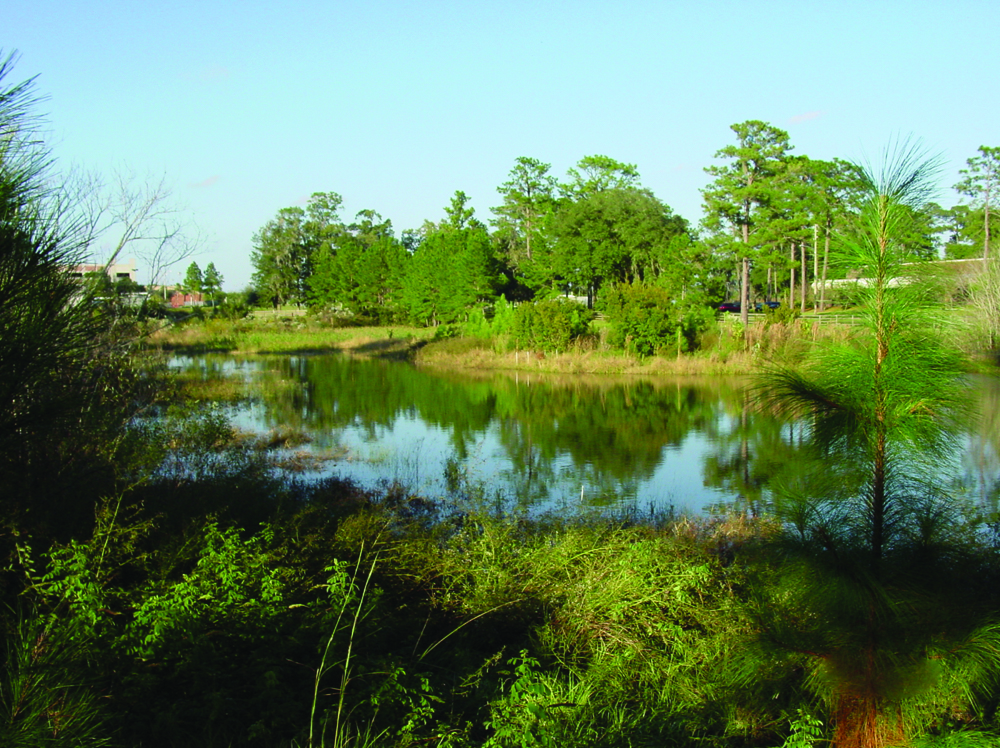Stormwater ponds are essential for the management of storm water runoff. They store and slow stormwater and reduce sediment transport, flooding, erosion and improve water quality.
Catch basins are much like the drain traps in household plumbing; they catch debris and separate it from the contaminated storm water. They also prevent sewer gases like hydrogen sulfide from escaping into the environment.
Runoff Management
The pollutants picked up by storm water runoff can be quite harmful to lakes, streams and wetlands. Pollutants carried by storm water include sediment, the nutrients nitrogen and phosphorus, bacteria, oil and grease, trash, metals and pesticides. These pollutants often increase with the amount of impervious surface on a site, such as pavement, sidewalks and rooftops.
Unable to soak into the ground, impervious surfaces quickly flood downstream during storm events and overwhelm natural channels and wetlands. Flooding harms homes and businesses, ruins septic systems, and destroys fish and wildlife habitat.
To control storm water pollution, the best thing you can do is reduce the volume of runoff leaving your property. Wet detention ponds are a common type of stormwater management practice designed to capture, store and conduct away unavoidable runoff. Ponds allow material to settle, making them a great solution for filtering sediment in runoff.
In addition to building wet detention ponds, many municipalities require non-structural practices like encouraging best management practices (BMPs), education and community involvement. Non-structural BMPs focus on planning and preventing runoff pollution before it starts. They can be as simple as picking up pet waste and lawn fertilizer, not littering, and limiting the use of pesticides and herbicides in residential yards. Lastly, by preserving the natural topography and vegetation of your property, you can slow down and filter stormwater before it leaves your site.
Drainage
Drainage is the engineered removal of fluid whether it’s water, mud puddles, marshland, river flows, or other liquids. It’s the same concept you use when you drain a sink or bathtub. The goal is to direct the water or other liquid to a place where it will be most useful.
Basins improve water quality by storing stormwater and slowly releasing it to the natural environment. They reduce flooding risks and decrease pollutant loads by reducing sudden flood pulses and delaying the timing of peak flows. During the design of a basin, drainage is often overlooked or not considered properly. However, good drainage is critical to the performance of a basin.
A basin’s drainage system can be surface or subsurface. Surface systems include point drains, catch basins, and infiltration basins. They are typically constructed of concrete or other materials. A point drain works by collecting water in a specific spot, similar to a shower drain. Catch basins and infiltration basins function by collecting water from a larger area and sending it to a lower level through a pipe.
Some older stormwater basins were designed primarily for flood control. They slow water to decrease downstream flooding, but they do not allow much of the detained water to infiltrate into the soil. Retrofitting a basin to increase infiltration and promote vegetation growth can help to address this problem.
Erosion Prevention
Erosion is a natural process that relocates soil particles from one location to another. But erosion can become a problem when it happens too quickly. As soil erodes, it loses nutrients and reduces fertility. It also clogs rivers and lakes with sediment and can cause flooding. Erosion can also damage buildings and roads.
Some of the most common causes of erosion include water, wind and ice. Rainwater is particularly damaging because it moves quickly through soil. The more rocky or coarse the soil, the faster it erodes. Wind is another major factor, especially in dry areas with little or no vegetation. Ice can erode soil, too, as it flows across the ground.
To prevent erosion, plant trees and shrubs with roots that can hold the soil in place. Ground covers like grass and mulch can also help bind soil together. In addition, barriers like retaining walls and erosion control blankets can protect land from erosion.
Another important part of erosion prevention is managing the amount of nutrient runoff from agricultural operations. Too many nutrients can lead to algae overgrowth, oxygen depletion and reduced water quality. This is called Eutrophication, and it can harm fish and other aquatic species. Soil erosion can prevent the natural transfer of nutrient-rich topsoil, and it also makes nutrients available to weeds that aren’t native to the area.
Flood Control
A key component of stormwater management is the use of basins to reduce the volume of water that flows into a waterbody. Basins can reduce the amount of pollution entering a stream by holding and allowing stormwater to slowly percolate through soils and vegetation before discharge.
Sediment retention basins are designed to trap sediment from runoff, allowing natural processes to settle and remove pollutants from the water (see Figure 1). A common design criterion is a containment volume of 3,600 ft.3/ac. (3,250 m3/ha). However, a containment volume alone is not enough to make sediment basins effective. In fact, a default containment volume often leads to the design of undersized sediment traps.
In addition to basins, other structural SMPs can be used to control stormwater flow and reduce pollutants, such as swales (see Figure 3.1). Swales are man-made or naturally occurring areas that promote water absorption in the soil and can also promote groundwater recharge.
Identifying site characteristics that present opportunities for stormwater management during the preliminary design phase can reduce project costs and improve the performance of the proposed SMPs. These features may include locations for proposed direct connections to existing infrastructure or soils with desirable permeability, low lying areas that are prone to nuisance flooding, and wetlands, riparian buffers, and steep slopes that are critical natural areas.

